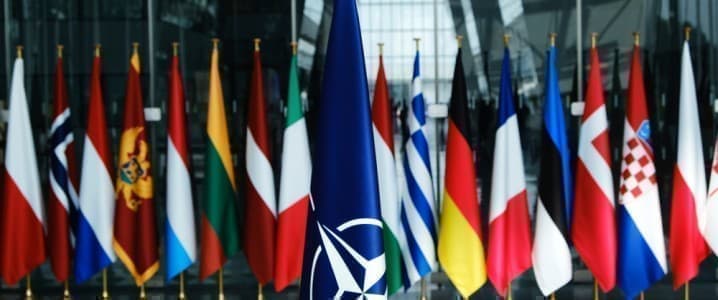In late January, NATO began what it has called its “largest military exercise since the Cold War.”
Steadfast Defender 24 involves 90,000 troops from all 31 alliance members as well as NATO invitee Sweden for four months of maneuvers by land, sea, and air.
You have to go all the way back to 1988 for the last NATO exercise that involved more troops: Reforger with 125,000. In between, the Trident Juncture exercise in 2018 included 50,000 personnel.
While official NATO documents don’t say outright that they’re training against a potential Russian offensive on allied territory, it’s clear that’s what is on their minds.
The alliance says it is testing responses “during a simulated emerging conflict scenario with a near-peer adversary.”
Exercise maps will show an adversary with a fictitious name, but privately my NATO sources acknowledge without hesitation that “of course this means Russia.”
Deep Background: Take a look at the geography and what the alliance will practice, and it becomes even more evident.
Roughly speaking, Steadfast Defender 24 includes two phases. The first, which kicked off slowly at the end of January, involves the transatlantic reinforcement of forces. This is in fact the key to see if the United States can effectively deploy a large number of troops and equipment to continental Europe to mount a defense.
Don’t underestimate the symbolism, as the United States nears a presidential election that culminates on November 5. The image of U.S. troops training alongside other nations in mock amphibious assaults in the Atlantic in the next two months, involving more than 50 naval vessels including aircraft carriers, frigates, and destroyers, could help assuage European fears of a less committed United States down the road.
The second phase of the exercise is equally crucial and is likely to show whether NATO is capable of defending its vulnerable eastern flank -- “every inch of allied territory,” as NATO officials like to put it.
Starting in mid-February and running till the end of May, many of the elements will take place on land and in the sky, involving up to 80 air platforms including F-35 fighter jets, helicopters, and drones, as well as more than 1,000 combat vehicles, including 166 tanks.
The epicenter is Poland, where a major river crossing will be attempted in March, but also in the Baltic states, with Germany acting as a major hub for reinforcement and coordination.
There will also be exercises throughout the Nordic region, as well as Czechia, Hungary, North Macedonia, and Romania.
Drilling Down
- This will also represent the first proper chance for NATO to test aspects of its new defense plans agreed at the Vilnius NATO summit in July, a 4,000-page document in which every ally should know exactly which part of alliance territory it should defend if NATO is attacked.
- Another big test is seeing how well the alliance’s Very High Readiness Joint Task Force (VJTF), which was created as a direct response to Russia’s annexation of Crimea in 2014, functions. It will be one of the bloc’s key components to defend any potential attack, with some 6,000 troops that should be deployable within days to any corner of the alliance.
- One of the aims of Steadfast Defender is ensuring this reaction force can be deployed together with various national forces once each year, starting from 2025. So this year is very much a test run.
- While the exercise has been planned for years, it comes at a pivotal time. Two years into Russia’s full-scale invasion of Ukraine, it should act as assurance that the alliance is ready in case the war creeps closer or even spreads across NATO members’ borders.
- While no Ukrainian troops are participating, the specter of the war in that country looms large in planners’ minds. Speaking to media in early February, NATO Brigadier General Gunnar Bruegner said “there is this unified sense that we need to go bigger, we need to train harder” when asked about the impact of the war on the alliance.
- The real question, however, is whether it will truly allay fears in Europe. Firstly, weapons deliveries to Ukraine have dropped alarmingly in recent months. The chairman of NATO’s military committee, Rob Bauer, said last fall that Western arms industries need to ramp up, as "the bottom of the barrel is now visible.”
- Then there have been plenty of recent official warnings that European allies must step up and prepare for the war potentially escaping containment to spread beyond Ukraine. And it’s not just Ukraine’s neighbors.
- The Belgian Army chief Michel Hofman suggested that Putin opening a second front in Moldova or the Baltics is not out of the question. And Hofman’s Swedish counterpart, Micael Byden, warned in late January that his countrymen “mentally must prepare for war,” triggering a slight panic as the public rushed out to buy extra fuel and survival kits.
By RFE/RL
More Top Reads From Oilprice.com:
- Diesel Prices Set to Surge in 2024
- From Coal to Clean: The Economic Challenge of Shifting Energy Paradigms
- Oil Markets Are Much Tighter Than Oil Prices Suggest



















However, there is a possibility that the NATO exercise could be aiming at providing indirect support to Ukraine which by changing the commander-in-chief of its armed forces has admitted for the first time that the game is over and that Russian forces are prevailing in the battlefields.
Either way, US-led NATO should be careful not to provoke Russia at a time when President Putin is sensing victory.
Dr Mamdouh G Salameh
International Oil Economist
Global Energy Expert